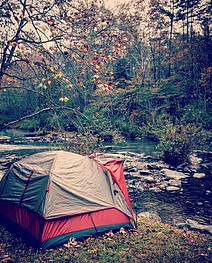
Shelter is necessary to give shade, to repel wind and rain and to keep in warmth. Sleep and adequate rest are vital to survival and the time and effort spent on making a comfortable shelter will make them much easier to get.
If you are the victim of a plane crash or a broken down vehicle, it may provide shelter or materials from which a shelter can be built. But, if there is fire or the threat of exploding fuel tanks, wait until the fire has burned out before any salvage attempts.
Unexpected Accident
If you find yourself in any of the following situations:
- An unequipped accident victim
- Trapped by an unexpected weather condition, like a sudden mist
- Caught in unsafe terrain during nightfall
- Exhaustion or injury prevents further travel
You may have to make do with any natural shelter you can find or until you can get a better grasp of your situation. In this case, any protection from wind, rain and cold will be welcome.
If movement down slope seems risky, traveling even a short way along the contour may bring you out of the wind. If no cave or crevice is available to give shelter, make use of any hollow in the ground. Add to its height, if you can, by piling up rocks, but make sure that any structure is stable. Use a backpack, if available, to increase the windshield before settling down on the leeward side.
If there is still daylight and you have no injuries to handicap you and are not isolated by unfriendly geography like unnegotiable cliffs or other barriers., it will be worth seeking possible better places in the vicinity.
For a long-term camp you should find a secure site with convenient access to your major needs.
Bad Places To Camp
Places where you don’t want to consider setting up a camp are:
- Hilltops exposed to wind (move down and look for shelter on the lee side)
- Valley bottoms and deep hollows – could be damp and, especially when the sky is clear, more liable to frost at night
- Hillside terraces where the ground holds moisture
- Spurs which are on a game trail
Where To Camp
If you are on high exposed ground, go lower down the hill to find a sheltered spot. However, on low, wet ground, you will need to climb higher to find somewhere securely dry. Look for somewhere sheltered from the wind, on rising ground that has no risk of flooding and is safe from rock falls or avalanches.
Remember that hot air rises and cold air settles, so valley bottoms will often contain pockets of colder air and in cold weather, be prone to frost and damp mist. In areas that get plenty of rainfall, terraces across a slope will often be damper than the steeper ground above and below them, as water collects there before flowing further downwards.
Ideally, you should be near water, with a plentiful supply of wood near at hand. Setting up camp too close to water, however, may lead you to be troubled by insects, and the sound of running water can hide other noises that could be warnings of potential danger or the sound of search and rescue parties.
On river banks, look for the high water mark. In mountain regions, streams can become torrents in minutes, rising as much as 17ft (5m) in an hour! Even on plains keep out of old watercourses, no matter how dry they are. Heavy rainfall in nearby hills can easily send water rushing down them in flash floods, with virtually no warning.
Choose ground that is reasonably flat and free of rocks and make sure that you have space to lay out signals so you can easily be spotted by rescue parties.
Check above your head for bees’ or hornets’ nests. Also, check for dead wood in trees that could come crashing down in the next storm or high wind. Keep away from solitary trees, which attract lightning. In forests, keep to the edges, where you can see what is going on around you.
Don’t camp across a game trail – you don’t want marauding animals as unwelcome guests, much less to find your shelter flattened by a herd of animals on their way to a waterhole. However, stay near any obvious human tracks.
The Home Front
You don’t have to be away from home to appreciate the need for a good camp site. Often times, during a disaster, it is an excellent idea to have a shelter right near your home.
It may be a good idea to look on your own property and find an area that can serve as an excellent shelter site. This may not make sense initially, but think about this: In the event of a natural or man-made catastrophe, where will desperate people go to find supplies and resources?
If you’re in an urban environment, people will likely go to any store, market or pharmacy they can find and grab whatever they need. In the event that all the stores are empty, desperate people will likely begin to start looking in homes – even other peoples’ homes!
Imagine if you could have a shelter, right on your own property that would allow you to store much needed supplies during a crises AND secure it from desperate people. Think that’s impossible? Well take a look here and think again.
By creating an Easy Cellar right in your own backyard or somewhere on your property, you can have all the peace of mind necessary to outlast any crisis and also not worry about having your vital supplies stolen by desperate people willing to secure their own survival at your expense.